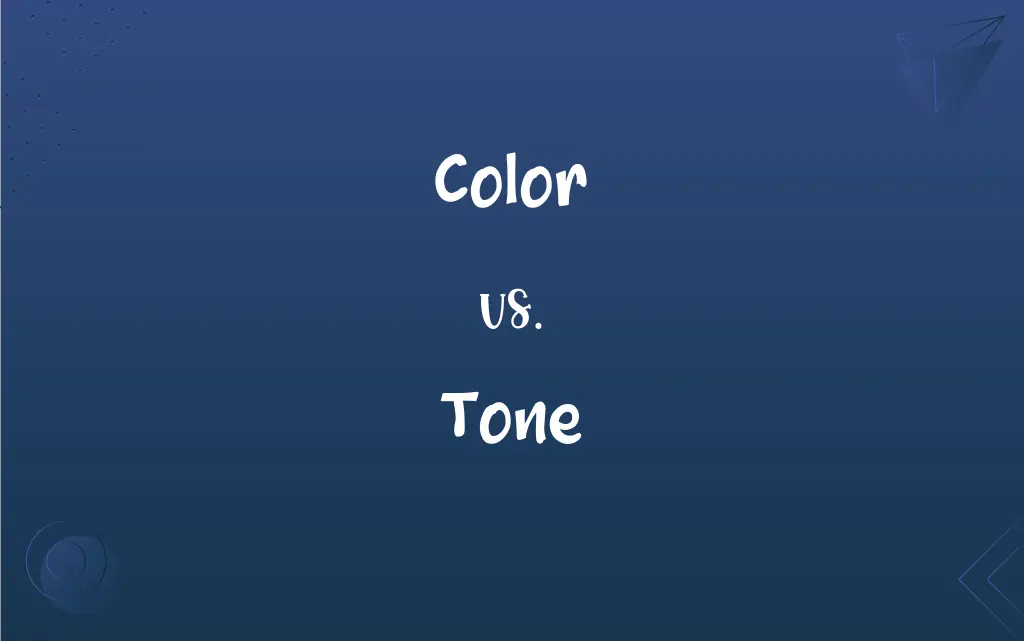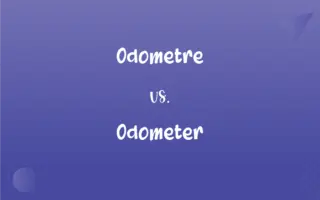Color vs. Tone: What's the Difference?
Edited by Aimie Carlson || By Harlon Moss || Updated on November 2, 2023
Color is the aspect of things caused by differing qualities of light being reflected or emitted, while tone refers to the lightness or darkness of colors.

Key Differences
Color is a visual attribute of things that results from the light they emit, transmit, or reflect and is perceived as red, blue, green, etc. Tone, in the context of color, refers to the lightness or darkness of a color, often created by adding white or black to the original hue. Each color can have a range of tones, from very light to very dark.
While color is often described in terms of hue, saturation, and brightness, tone is specifically about the mixture of light and darkness in a color. For instance, a color could be described as "bright red," while its tone could be "light pink" when white is added or "dark crimson" when black is added.
Color is fundamental in the differentiation of appearance and is one of the first characteristics noticed. Tone, on the other hand, adds depth and dimension to colors, influencing the mood and the visual impact. Different tones of the same color can evoke different feelings and atmospheres.
In terms of usage, color is the primary characteristic that defines the essence of an object's appearance. Tone is a secondary characteristic that further refines the visual experience, affecting the perceived weight and temperature of colors. For example, warm colors can appear warmer with a lighter tone and cooler with a darker tone.
In artistic contexts, color is used to create a first impression, grab attention, or distinguish an object, while tone is used to create contrast, volume, and a sense of space. Tonal variations can suggest form and light within artwork, allowing for the illusion of three-dimensionality.
ADVERTISEMENT
Comparison Chart
Definition
The quality of an object or substance with respect to light reflected by the object.
The degree of lightness or darkness in a color.
Use in Art
Fundamental for composition and aesthetics.
Used for shading and depth.
Impact
Defines the vibrancy and energy of a visual.
Determines the mood and atmosphere.
Variations
Achieved through different wavelengths of light.
Achieved by mixing with white or black.
Perception
Can be subjective based on individual eyesight.
Influences the perception of weight and temperature in art.
ADVERTISEMENT
Color and Tone Definitions
Color
A pigment or dye.
She added a splash of color to her dress.
Tone
A particular quality of color.
The room's tone was a soft, muted grey.
Color
The character of surface distinct from form.
The color blue often calms the mind.
Tone
A musical or vocal sound with reference to its pitch.
The piano had a rich, warm tone.
Color
A property causing visual sensation.
Autumn leaves show a spectrum of color.
Tone
A manner of expression in writing.
His writing had an authoritative tone.
Color
Vividness of visual appearance.
The sunset was bursting with color.
Tone
The normal level of firmness of a muscle.
Regular exercise helps maintain muscle tone.
Color
Variety or diversity.
The festival was full of color and life.
Tone
The general character or attitude.
Her letter had a friendly tone.
Color
The appearance of objects or light sources described in terms of the individual's perception of them, involving hue, lightness, and saturation for objects, and hue, brightness, and saturation for light sources.
Tone
A sound of distinct pitch, quality, and duration; a note.
Color
The characteristics of light by which the individual is made aware of objects or light sources through the receptors of the eye, described in terms of dominant wavelength, luminance, and purity.
Tone
The interval of a major second in the diatonic scale; a whole step.
FAQs
Do all colors have tones?
Yes, all colors can have a range of tones from light to dark.
How is tone different from color?
Tone refers to the lightness or darkness of a color.
Is white a color or a tone?
White is considered a color; when added to other colors, it affects their tone.
Can the tone of a color change its perception?
Yes, different tones can change how we perceive a color.
What is a mid-tone color?
A color that is neither very light nor very dark.
Can colors have the same tone but different hues?
Yes, different hues can have the same level of lightness or darkness.
What defines a color?
The specific wavelength of light reflected.
Is it possible to have a color without tone?
In practice, no; every color displayed will have a tone due to its lightness or darkness.
Can tone affect the mood of a painting?
Yes, the tone can significantly affect the painting's emotional impact.
Does the tone of a color affect its saturation?
Yes, adding white or black can decrease a color's saturation.
How many colors are there?
The number is infinite, due to variations in hue, saturation, and tone.
Can everyone perceive color and tone the same way?
Perception can vary due to factors like lighting and individual eyesight.
How do artists choose colors and tones?
They consider the emotional effect and visual balance they want to achieve.
Can a single color create a sense of depth?
Yes, through the use of varying tones.
What role does tone play in black and white photography?
Tone creates contrast and depth, critical in the absence of color.
Does lighting affect color tone?
Yes, different lighting can change the perceived tone of a color.
Is black the absence of color?
In terms of pigment, yes; in terms of light, no.
Is grayscale considered a color or a tone?
Grayscale refers to a scale of tones from black to white.
What determines a color's warmth or coolness?
The hue and the tone together affect a color's temperature.
Do color and tone influence each other?
Yes, changing one can affect the perception of the other.
About Author
Written by
Harlon MossHarlon is a seasoned quality moderator and accomplished content writer for Difference Wiki. An alumnus of the prestigious University of California, he earned his degree in Computer Science. Leveraging his academic background, Harlon brings a meticulous and informed perspective to his work, ensuring content accuracy and excellence.
Edited by
Aimie CarlsonAimie Carlson, holding a master's degree in English literature, is a fervent English language enthusiast. She lends her writing talents to Difference Wiki, a prominent website that specializes in comparisons, offering readers insightful analyses that both captivate and inform.































































